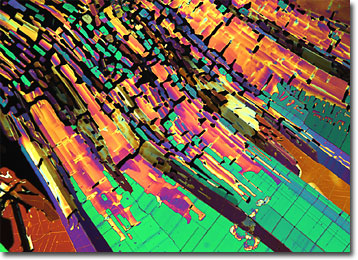Polarized Light Microscopy Digital Image Gallery
Dicloran
Dicloran is a nitroaniline compound widely utilized as a fungicide. The yellow, crystalline powder is approved for general use in the United States and is sold under a variety of trade names, including Botran, DCNA, Ditranil, and Allisan.

View a second image of Dicloran
A member of the substituted aromatic class of pesticides derived from the parent compound hexachlorobenzene, dicloran is an effective protectant of seeds and ornamental plants. The fungicide may also be utilized on fruit and vegetable crops either before or after harvest to control diseases and may be applied via a variety of methods, including aerial sprays and dusts. Some of the most common items that dicloran is currently utilized to treat are grapes, lettuce, celery, tomatoes, and peaches. The fungicide is sometimes found in formulations with other pesticides, but is incompatible with certain oil-based chemical compounds.
Dicloran is most active against Rhizopus, Botrytis, Monilinia, Sclerotium, and Sclerotinia fungal species. The pesticide’s mechanism of action is believed to be non-specific inhibition of cell division, which facilitates the disruption of nuclear stability. Classified as a class III toxin by the Environmental Protection Agency (EPA), dicloran poses a moderate hazard to fish, birds, and beneficial insects. Studies have also demonstrated that the substance may act as a skin sensitizer and may generate phototoxicity.
